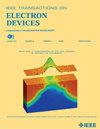Investigation of Heavy-Ions-Induced Leakage Current Modes and Degradation Mechanism in SiC MOSFETs Under Complex Heavy Ion Conditions
IF 2.9
2区 工程技术
Q2 ENGINEERING, ELECTRICAL & ELECTRONIC
引用次数: 0
Abstract
A comprehensive investigation is conducted to explore the heavy-ions-induced leakage current (HIILC) modes and degradation mechanism in silicon carbide (SiC) MOSFET. The ions used in irradiation experiments had different linear energy transfer (LET) values, which aimed to simulate complex ion conditions in aerospace applications. The distinct HIILC degradation modes of SiC MOSFETs are observed first under heavy ion irradiation with different LET values. Under irradiation with low LET ions, the overall leakage current degradation is dominated by the degradation of the drain current. Conversely, gate current has a higher degradation rate under irradiation with high LET ions. The degradation mechanisms of leakage current are discussed by combining the defect analysis of irradiated samples and simulation results. We propose and verify for the first time that the generation of stacking faults (SFs) in SiC MOSFETs under heavy ion irradiation is the cause of drain current degradation regardless of LET values. Additionally, under high LET ion irradiation, damage caused by a high electric field in the gate oxide is presumed to be attributed to the rapid degradation in gate current. The proposed theory provides a foundation and guidance for reinforcing against HIILC degradation of SiC MOSFET by addressing the process and material characteristics of the SiC.研究复杂重离子条件下 SiC MOSFET 的重离子诱导泄漏电流模式和劣化机制
本研究对碳化硅(SiC)MOSFET 的重离子诱导漏电流(HIILC)模式和降解机制进行了全面研究。辐照实验中使用的离子具有不同的线性能量传递(LET)值,旨在模拟航空航天应用中的复杂离子条件。在不同 LET 值的重离子辐照下,首先观察到了 SiC MOSFET 不同的 HIILC 降解模式。在低 LET 离子的辐照下,漏极电流的衰减主导了整体漏电流的衰减。相反,在高 LET 离子的辐照下,栅极电流的衰减率较高。我们结合辐照样品的缺陷分析和模拟结果,讨论了漏电流的衰减机制。我们首次提出并验证了在重离子辐照下,SiC MOSFET 中堆叠故障(SF)的产生是漏极电流劣化的原因,与 LET 值无关。此外,在高 LET 离子辐照下,栅极氧化物中的高电场造成的损坏被认为是栅极电流快速衰减的原因。所提出的理论通过解决碳化硅的工艺和材料特性问题,为强化碳化硅 MOSFET 的 HIILC 退化提供了基础和指导。
本文章由计算机程序翻译,如有差异,请以英文原文为准。
求助全文
约1分钟内获得全文
求助全文
来源期刊

IEEE Transactions on Electron Devices
工程技术-工程:电子与电气
CiteScore
5.80
自引率
16.10%
发文量
937
审稿时长
3.8 months
期刊介绍:
IEEE Transactions on Electron Devices publishes original and significant contributions relating to the theory, modeling, design, performance and reliability of electron and ion integrated circuit devices and interconnects, involving insulators, metals, organic materials, micro-plasmas, semiconductors, quantum-effect structures, vacuum devices, and emerging materials with applications in bioelectronics, biomedical electronics, computation, communications, displays, microelectromechanics, imaging, micro-actuators, nanoelectronics, optoelectronics, photovoltaics, power ICs and micro-sensors. Tutorial and review papers on these subjects are also published and occasional special issues appear to present a collection of papers which treat particular areas in more depth and breadth.
 求助内容:
求助内容: 应助结果提醒方式:
应助结果提醒方式:


